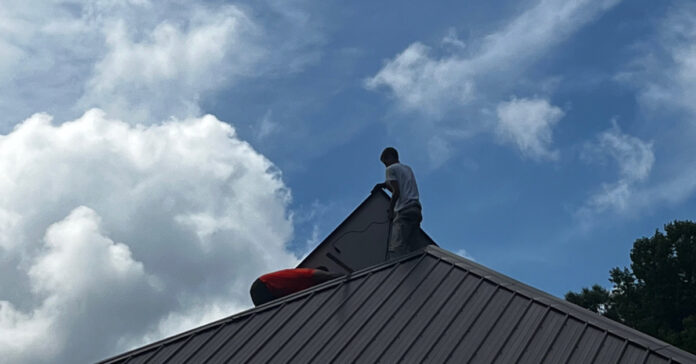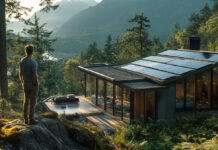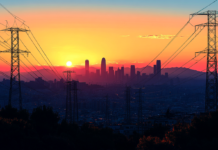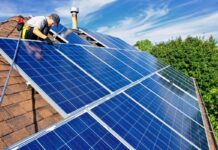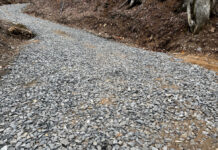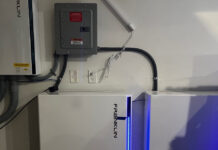Our solar system install is finally underway! Here’s a blow-by-blow account of how it is going.
Day 1
We were given a four-hour window during which the install would start. That made sense because the installer’s crew is from a city a couple hours away and I’m guessing they need to load their trucks before leaving. Happily, four guys show up early in the window, their pickup truck adorned with ladders and loaded with tool boxes.
But they have none of the solar panels with them. They are being delivered by a third party. The installers don’t know what kind of a truck the delivery driver is driving, so we do not know if he can make it up the dirt road and then our driveway. This is complicated by the fact their cell phones don’t work up here, regardless of the carrier. I give them all the password for our guest WiFi network and they log in. Preparations are made to drive the pickup down the mountain to meet the driver and offload the equipment into the pickup bed. The batteries and their pallets weigh more than 500 pounds each, so how they achieve that will be interesting to see.
Then a sprinter van grinds its way slowly up the hill. The panels have arrived! The batteries are there too. Now the real work can begin.
Planning and Design Revisions
Before long, two other guys arrive, one of whom is the licensed electrician. They younger crew members scamper up to the roof and start measuring and laying out the roof racks. The more seasoned fellows (none of them is over 40 and the whole crew is male) start trying to determine if they can actually install things where the plans call for. Turns out, the location of the batteries is about too narrow to meet code, so they have to be moved to the adjacent wall. This is what happens when the installation plan is designed by people in another state who rely in part on photos and measurements taken from space via satellite.
Based on the electrical code, certain items—like the disconnect—have to be outside near the meter. Other items can also be mounted on the exterior wall, but everyone would prefer them to be inside, even though the batteries and other components are waterproof. The exterior wall is cast concrete with a rock veneer, so drilling through it to run cables and wires back and forth is a challenge. It even makes mounting cabinets more of a chore than it would be on a frame house.
We also discuss how to run the cable from the roof to the inverter below. I am pleased to be included in this conversation, and I make recommendations and point out where existing cable runs are. This works out well. As I understand it, the three groups of panels will be set up as two strings of 10 and 11 panels. The cables will run through the roof and into the attic. They will then run from one side of the house to the other and come down the same way as the conduits for the deck lighting.
Drilling and Securing
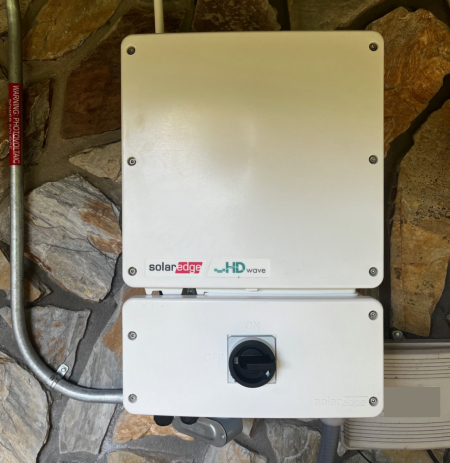
Now that plans are made, the drilling starts. By the end of the day, we have the inverter mounted to the wall, the disconnect box that ensure firefighters won’t be shocked by the solar panel power is in place, and what looks like at least a two-inch hole is drilled through the exterior wall. Provisions have been made for where the generator socket will go so we can plug the generator in and charge the batteries during a long-term outage.
On the roof, the anchors for the rack have been secured, but no rack or panels have been installed.
Most of the crew is staying in a bed and breakfast in a “nearby” town (40 minutes away), so I give them recommendations for dinner and they head down the mountain.
Day 2
The guys get here right at 9 a.m., which is when they said they would arrive. Their timeliness impresses us because our experience with local contractors is if they say they will be there at 9, its an aspiration, not a commitment. I think they leave their shop around 9 and we are lucky to see them by 10. God forbid they have to go to Lowes to pick something up; it’s at least a two-hour round trip.
Mounting racks are handed up by one guy on the ground and two fellows on the roof carry them around and lock them into place. Then panels are handed up, wire together, and attached to the rack. They are large, so we are lucky it isn’t windy. I can’t see what is going on up there because it is well above my head. I will have to walk up the mountain opposite to see how it looks. By the end of the day, all but two panels and optimizers are installed.
The hole is drilled in the roof and a boot is installed so the DC cables can pass through it in a weather-tight manner.
The 450 pound 13.5 kilowatt batteries will sit on a cement floor, but they are also attached to the wall. Not comfortable securing these to wallboard, the crew open up the wall and start reinforcing it with 4x4s. I found this to be above and beyond.
Power Outages
In an ironic twist, we experienced two power outages the week prior to installation. They lasted two to four hours each. I’ve lost count of how many power outages there have been so far this year, but it’s well over a dozen. That’s an average of one every two weeks, and they come rain or shine. With this system, we hope to have seen the last of them.
I am keeping news of our solar power somewhat quiet because I don’t want a line of people showing up at the house when the power is out, but my wife has mentioned it to a couple of friends. One is interested in solar for the same reason we are, because of the high incidence of power outages. This area is already a hotbed of Generac generators, but it may become one for solar power as well.
I will provide the next solar update on next Wednesday’s post. With any luck, we’ll be ready to go live. M0ydeadline has been Independence Day and we’re cutting it close, but it is still possible.

